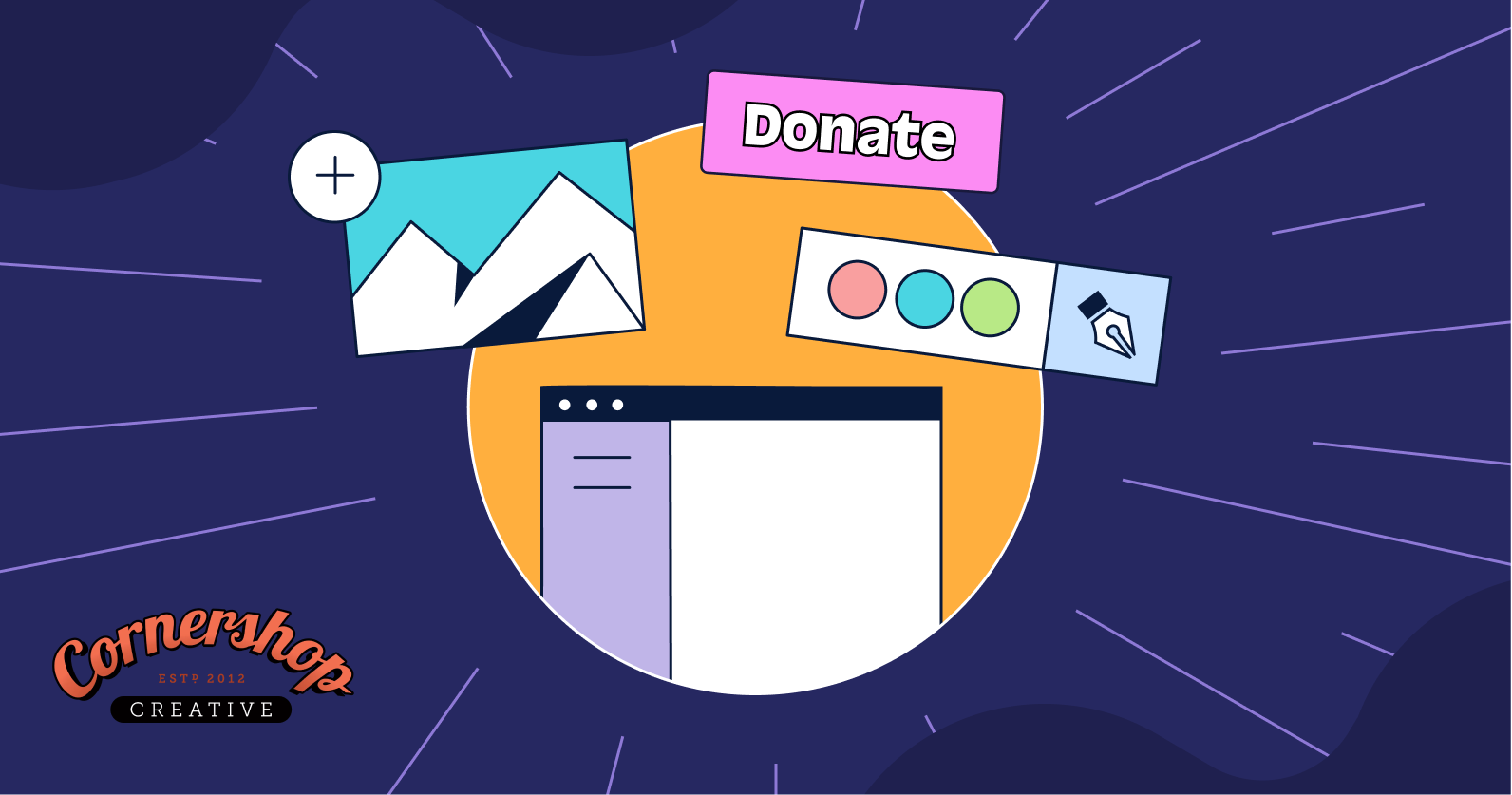
Taking your advocacy campaign online doesn’t have to be a challenge, especially with an effective website. Learn these web design tips to get you started!
Advocacy can go a long way to sparking change in the greater community. Historically, campaigning for an important cause and supporting others is something nonprofits have consistently championed. But not all advocacy campaigns ultimately reach their goals.
Offline activities can make a difference in your advocacy campaign’s success, but running such a campaign without an online strategy and the help of digital tools can inhibit your progress. That’s why it’s important to take your advocacy online.
If you’re looking for ways to launch a successful advocacy campaign online, there are some key ways your website can assist. Focusing on crucial web design elements will make your campaign accessible, easy to understand, and drive more results.
That’s why we’ve outlined some of the top web essentials for taking your advocacy online:
- Clearly Feature Your Campaign
- Focus on Your Landing Page
- Use High-Quality Visuals
- Encourage Donations
- Keep Your Site and Data Clean and Updated
These strategies can help you meet your advocacy goals, all while maintaining a positive public image and demonstrating the important work you’re doing in your community. Let's get started.
1. Clearly Feature Your Campaign
A large part of your website’s purpose is to educate visitors about your organisation, mission, and current goals and activities. When you take your advocacy online, clearly featuring your campaign front-and-centre will direct more traffic to your advocacy efforts and drive more results.
Here are some tips to consider as you structure your website:
- Present the information in a clear and simple way. Rather than overwhelming visitors with tons of information about what they need to do, focus on creating a strong campaign message that shares what your campaign is about, what supporter participation will accomplish, and what progress your campaign has already made.
- Use calls to action (CTAs). Make it clear what you’re asking people to do as they get involved with your campaign. This might mean signing up for an email list, signing a petition, or getting in touch with their representative. Clear CTAs that stand out across your website and direct visitors to the next step will help drive engagement.
- Provide clear opportunities for engagement. Sign-up pages and social media share buttons can help inspire action. Encourage your web visitors to engage with your content and spread awareness by sharing it with their larger circles.
Clearly featuring your advocacy campaign on your website provides supporters with a central location to learn everything about your campaign and access the tools they need to get involved.
2. Focus on Your Landing Page
According to research, many web visitors exit a webpage after 10-20 seconds. This means it’s critical that your landing pages demonstrate the value of your campaign within the first 10 seconds.
How can you show value that quickly?
You must encourage visitors to continue exploring your website. Many visitors won’t go beyond the first page they land on, but offering the right CTAs and standout pieces of content can help your case. For example, you can:
- Feature important information on the first page. Your landing page is where users will end up first, so be sure to include a brief, but compelling description of what your advocacy campaign is about so they’re inclined to remain on your site.
- Be straightforward. Part of the success of your advocacy campaign relies on trust. Be truthful from the very first page about what visitors are signing up for before capturing their information. The more straightforward you are about your campaign, the more support and success you’ll see.
Including important information on your landing page that encourages involvement and trust will help your organisation succeed in its advocacy efforts. From the very beginning, you want to cultivate relationships with those who are going to support your campaign. Make those 10 seconds count!
3. Use High-Quality Visuals
People respond strongly to visuals, especially when they are compelling or evoke an emotion.
Featuring high-quality visuals across your website will help tell your organisation’s story, explain your advocacy campaign’s importance, and encourage people to get involved.
Here are some ways you can incorporate visuals into your web design:
- CTAs. Your CTAs don’t have to just be buttons or links. Use banners or other engaging graphics that will encourage your visitors to click through to your donation page, newsletter sign-up, or registration page.
- Photos and videos. Remind visitors who your campaign impacts by featuring real people in inspiring visuals. Throughout your website, displaying photos of your constituents and videos that effectively summarise your campaign will help encourage your supporters to take action.
- Donations. Your donation page is one of the most important components of your website. Make it stand out with a high-quality image of your constituents so it’s clear who their donation will be supporting.
It’s worth noting that too many visuals will distract visitors from your main content. Finding just the right balance between text, graphics, and videos will create an impactful experience for your audience.
If you’re having issues organising the media currently uploaded to your website, consider using a media cleaner tool to remove duplicates and unused images. Once those are cleaned up, you’ll be able to sort through and find the right graphics to highlight your cause.
4. Encourage Donations
As with any type of campaign, monetary support can go a long way. When you plan your advocacy campaign and prime your website to feature your goals, constituents, and progress, you should also focus on your donation process.
Your website should make it clear where and how supporters can donate to your cause, through both one-time gifts and monthly giving. This means directing donors to your donation page via effective CTAs, featuring the page in your top navigation menu, and offering a straightforward process from there.
Here are some tips to encourage donations for your campaign:
- Be patient. Not everyone is going to donate, and not everyone is going to donate right away. Are you capturing email subscribers on your website and petition tools? As your campaign goes on, you can send out donation appeals via email and convert some of those supporters to donors.
- Use integrated donation tools. Integrated donation tools can make organising your donations and donor information much easier. Be sure to use tools that allow you to embed donation forms directly onto your website, offer an integrated payment processing system, save donor information to your donor database, and include the option to make a recurring gift.
- Keep the form simple. Overly complicated donation forms are just one of the many mistakes that could cost you a donor. Make sure you only ask for essential information, including contact and payment details, and that the form is presented in a straightforward manner.
- Don’t forget branding and security. Branding your donation page to match the rest of your website’s design by featuring your logo, colour scheme, and even the same fonts, will instill trust in your donors and reassure them that their information is going straight to you. Similarly, using a PCI-compliant payment processor and keeping your site encrypted will also encourage more donations because it’s evident that all donor information will remain secure.
Your advocacy campaign is important to your organisation, and encouraging donations will help you continue working toward your goals. When you focus on how your website presents the donation process, you can encourage even more support from your audience.
5. Keep Your Site and Data Clean and Updated
Of course, performing a redesign of your website or updating a few pages isn’t going to be a long-term solution. You need to consistently maintain your website in order to keep it updated, safe, and valuable for visitors—especially during an important campaign.
That’s why nonprofit website maintenance is one of the most important things to keep in mind as you continue launching campaigns. The better you maintain and update your content, the more engagement you’ll see.
Here are a few website maintenance tips to help you get started:
- Ensure everything works. This includes donation forms, registration pages, plug-ins, and all menus and links. Make sure there are no broken links, and that anything submitted on a form is going through successfully.
- Update your content on a regular basis. Keeping your blog, events, and campaign information up-to-date will show web visitors that your organisation is active and encourage them to take part in your advocacy campaign.
- Compress images for page speed. One of the most common causes of slow page speeds is large, uncompressed images. If your pages take longer than a few seconds to load, you’re going to lose visitors.
- Ensure your website is mobile friendly. Many of your website’s visitors will be viewing your content on a mobile device, especially if they first encounter you through social media. That’s why it’s crucial that your website is easily readable from any device, and that your photos, videos, and text are all mobile responsive.
- Optimise for SEO. This means going through your content and establishing targeted keywords to grow your organic traffic, checking for broken links, and fixing pages that lead to a 404 error.
Part of your website maintenance process also involves practicing good data hygiene. This means cleaning up data that is outdated, duplicated, incorrect, or incomplete. The more you maintain your website and your data, the more updated and complete information you’ll have on the supporters of your advocacy campaign. Check out NPOInfo’s guide to data hygiene for more information about this process.
Whether your goal is to solicit petition signatures, organise an event, or bring in more monetary support for your advocacy campaign, your website will be essential to your campaign’s success. Be sure to keep the focus on your web visitors’ experience, clearly feature your campaign, and encourage involvement from all ends so that you can be successful. Best of luck!
Stay in the loop. Delivered to your inbox twice a month.

Director of site builds at Cornershop Creative, De’Yonté has spent the last three years specialising in WordPress and conversion optimisation, and is an active proponent of coding guidelines.




